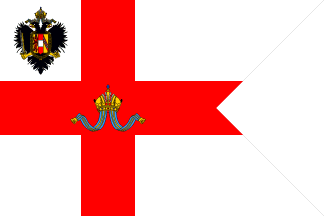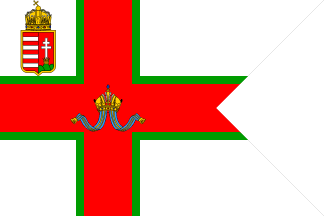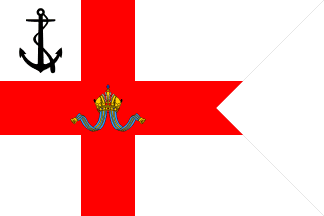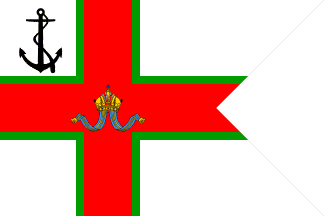![[Austria-Hungary War Ensign]](../images/a/ah-waren.gif) by Željko Heimer, 14 March 2004
by Željko Heimer, 14 March 2004
Last modified: 2015-07-18 by rob raeside
Keywords: yacht club | rank flag: yacht club | austria | hungary | austro-hungarian empire | cross (red) |
Links: FOTW homepage |
search |
disclaimer and copyright |
write us |
mirrors
See also:
The Imperial and Royal Yacht Squadron (k. u. k. Yachtgeschwader) was granted
with a special grant thr right for its members to hoist the Naval Ensign as the
ensign on the yacht and pleasure boats registered in Austria-Hungary belonging
to the members of this elite club.
The Squadron was established by naval
officers in 1891 and was headquartered in Pula. The membership list from 1903 [Liste,
1903] shows that the Squadron members included numerous Erzherzogs, Princes,
Counts and Barons, naval officers and high government officials and high society
members from different countries. The five Flaggenofficiere of the
association in 1903 were: the Commodore Erzherzog Franz Ferdinand;
Vice-Commodore for Austria Alfred Graf Harrach, Vice-Commodore for Hungary
Philipp Prinz von Sachsen-Coburg-Gotha; Rear Commodore for Austria Karl Graf
Buquoy von Longueval and Rear Commodore for Hungary Geza Graf Andrassy.
The annual issue of k.u.k. Marinealmanach for 1914 provides the list of
boats registered in Austria-Hungary belonging to the members, mostly sail-boats,
but also nine motor boats. The boats were registered in cities on Adriatic coast
of Istria and Kvarner, but also on inland lakes of Austria and Hungary as well
as in Danube ports.
The k.u.k. Yachtgeschwader was re-established at
Attersee in Upper Austria in 1991.
Željko Heimer, 17 October 2007
![[Austria-Hungary War Ensign]](../images/a/ah-waren.gif) by Željko Heimer, 14 March 2004
by Željko Heimer, 14 March 2004
The k.u.k. Yachtgeschwader is interesting vexillologically since it was granted the right to fly the
Kriegsflagge (naval ensign) on the vessels of their members instead of the dual merchant ensign.
Željko Heimer, 14 March 2004
I know that the k.u.k. Yachtgeschwader members were entitled to use the Austro-Hungarian War Ensign (Kriegsflagge)
on their private boats, but the exact scope of this privilege is not completely clear to me.
Tomasz Wyżyński, 14 March 2004
Tomasz and I discussed in details various usage forms. Surely the copy of the statutes might shed some light on it, but according to my
limited knowledge to the yachting flagging practice, I believe that this summarizes all the questions we rised with some of my answers:
- vessels (ships and boats) were entitled to fly the Kriegsflagge (naval
ensign) based on their port of registration - i.e. foreign ships could not do that
even if their owner were members of the club and in the ships were in
Austro-Hungarian waters
- it remains open what ensign would be flown if there was no k.u.k. Yachtgeschwader member on board of such ship entitled to
Kriegsflagge
Željko Heimer, 14 March 2004
Nearly the last illustration from Znamierowski [zna99]
on page 251 shows part of
flagchart from "Nachtrag III zum Flaggenbuch" Berlin
1913, showing flags of yacht club officers in Austria-Hungary in
1913. In addition to the naval ensign (erroneously
translated "merchant flag") there are nine rank flags,
one for the commodore (highest rank in YC), and two sets of four
for lower ranks and members' flag, each for either Austria or
Hungary. The difference is in the crown and the coat-of-arms used - for
Austria the Austrian imperial crown and the black double eagle,
and for Hungary the St. Stephen's crown and the Hungarian coat-of-arms.
It is my guess that the two sets have been in use regarding the
ports of registrations of the vessels, those in Istria, Dalmatia
and Austrian held parts of Italy were using Austrian version,
while the vessels from Rijeka/Fiume and northern Croatian coast
used Hungarian version. I do not know how many such flags were in
use, possibly more in Italian parts of the empire (Venice,
Trieste) and maybe in Pula - being important military port where
certainly was quite a number of high ranking Austrian naval
officers living, which were naturally (probably) highest ranking
YC officers' too. Regarding Hungarian ensigns, apart from Rijeka,
and maybe Kraljevica (Porto Re) I doubt that there was important
port that would have YC members. But this whole paragraph is, of
course, a speculation.
Željko Heimer , 1 April 2000
The yachting flags would be flown at main mast or some other convenient place (as jack on smaller boats)
according to the highest member present on board, no matter what flag the owner was entitled
to (i.e. if owner was entitled to a higher flag and his skipper to a lesser, when
the owner is away, the lesser flag would have to be hoisted, I guess).
Željko Heimer, 14 March 2004
 image
by Željko Heimer, 17 October 2007
image
by Željko Heimer, 17 October 2007
The flag of the commodore is a white swallow-tailed flag with a red cross
bearing the Austrian imperial crown in the middle.
Željko Heimer, 17
October 2007
 image
by Željko Heimer, 17 October 2007
image
by Željko Heimer, 17 October 2007
 image
by Željko Heimer, 17 October 2007
image
by Željko Heimer, 17 October 2007
The flag of the vice-commodore is equal to the flag of commodore, with the
middle coat of arms added in canton. For the Hungarian part of the Monarchy the
coat of arms of Hungary is set in canton and the cross is fimbriated in green.
Željko Heimer, 17 April 2007
 image
by Željko Heimer, 17 April 2007
image
by Željko Heimer, 17 April 2007
 image
by Željko Heimer, 17 April 2007
image
by Željko Heimer, 17 April 2007
The flag of the rear commodore is equal to previous pattern, but in place
of the coat of arms it have a fouled anchor, also in two variants, one for
each part of the Dual Monarchy.
Željko Heimer, 17 April 2007
 image
by Željko Heimer, 17 October 2007
image
by Željko Heimer, 17 October 2007
 image
by Željko Heimer, 17 October 2007
image
by Željko Heimer, 17 October 2007
The flag of honorary members, founders and first class members is of the same
pattern as the flag of vice-commodore, but in shape of a triangular pennant. Of
course, in two variants, one for the part under Austrian crown (i.e.
Cisleithania) and one for countries of Hungarian crown (i.e. Transleithania).
Željko Heimer, 17 October 2007
The burgees appears on this 18ct gold brooch
which was made for the Archduke Charles Stephen when he commissioned the motor
yacht Ossero in 1891. The Archduke was clearly the founding commodore of the
IRYS! The motor yacht later changed its name to Delmat and transported Archduke
Franz Ferdinand before he was assassinated.
Martin Bosher, 12 June
2015
Another illustration and some confirming information here:
http://www.nikodubokovic.com/yacht-geshwader%20-%20elite%20yacht%20club.html
Peter Hans van den Muijzenberg, 12 June 2015
 image by Željko Heimer, 17 October 2007
image by Željko Heimer, 17 October 2007
 image by Željko Heimer, 17 October 2007
image by Željko Heimer, 17 October 2007
The flag of the ordinary members if of equal design as the rear commodore
flag, in triangular shape, and again, in two variants for two parts of the
country.
Željko Heimer, 17 October 2007
Sources:
- "Liste der Ehrenmitglieder, Stifter und Mitglieder des k.u.k.
Yachtgeschwaders, Berichtigt bis Ende Jänner 1903", Buchdruckerei J. KrmpotiŠ &
Co. in Pola, 1903
- Nachtrag III zum Flaggenbuch, Berlin, 1913, as reprinted
in Alfred Znamierovski: The World Encyclopedia of Flags, Lorenz Books, New York,
1999, p. 251.
- many members were at the same time high military officers - would they have hoisted their k.u.k. Yachtgeschwader flags at military
vessels (I think not) and would they have hoisted their military (e.g. admiral's) flags on their/others' private ships when on board (I
think quite likely)?
- the Navy had several smaller boats and yachts that were used documentedly in the yachting regates and other yacht club
festivities. These were commissioned vessels usually used by highest admirals monitoring the races and similar. Would they use military
flags (of course, I guess), but would they also have k.u.k. Yachtgeschwader flags hoisted at the time when the admirals were
obviously performing the k.u.k. Yachtgeschwader functions?
- what about the foreign members owning ships registered abroad. They would have no right to fly the
naval ensign on those ships, I am certain, but would they have been entitled to fly the k.u.k.
Yachtgeschwader flags (I guess so)? They were usually members of two or more
prestigious clubs. Would they use more than one flag, or would they choose one set
according to where on Earth they would be? I suppose that there were other privileges of the membership that would
encourage someone to join (for a very high fee!), but the membership flags, but they would be clear indication of such privileges.
- regarding the close link of the club with the Navy, would the members be entitled to honorary military ranks (possibly
only in ceremonial sense, to wear uniforms at balls etc.)? I think not.
- the k.u.k. Yachtgeschwader was divided into two parts, the Austrian and the Hungarian, as the flags clearly indicate. Were the members
registered in the two "houses" (for lack of the better name), so they would use the "national" variant of their "house", or was the
choice left to the member as he pleases in certain occasion, or was it connected with the port of registration (but then what when the
member is guest on somebody else's boat)? The club had ships and boats registered in Pola/Pula and
other Istrian cities, probably also in Fiume/Rijeka, but also on inland lakes and rivers, both in
Austrian and Hungarian part of the Empire.
- it is not clear to me nor to Tomasz whether the yachting flags were used also by the other yacht clubs in the Empire, or
whether they had other sets. Such clubs would be Motor-Jachtclub von Österreich and
the Kaiserl. Königl. Union-Yacht-Club. As far as I understand, these other clubs must have used the
dual merchant ensign, so their yacht could be easily
differentiated from the k.u.k. Yachtgeschwader yachts according to this element only.
Željko Heimer, 14 March 2004
- another interesting link is at http://www.spielberg.at/gemeinde/geschichte/brioni.rtf
describing
yachts used at regattas in Brioni (I admit I have not read it carefully though, so I do not know how much flag content it has,
possibly very minor). However it shows how yachts were navigated in regattas by other members, not the owners, and that would pose the
questions above regarding the flagging practice.
Željko Heimer, 14 March 2004